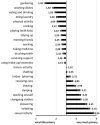Eyes on privacy: acceptance of video-based AAL impacted by activities being filmed
- PMID: 37469701
- PMCID: PMC10352951
- DOI: 10.3389/fpubh.2023.1186944
Eyes on privacy: acceptance of video-based AAL impacted by activities being filmed
Abstract
Introduction: The use of video-based ambient assisted living (AAL) technologies represents an innovative approach to supporting older adults living as independently and autonomously as possible in their homes. These visual devices have the potential to increase security, perceived safety, and relief for families and caregivers by detecting, among others, emergencies or serious health situations. Despite these potentials and advantages, using video-based technologies for monitoring different activities in everyday life evokes concerns about privacy intrusion and data security. For a sustainable design and adoption of such technical innovations, a detailed analysis of future users' acceptance, including perceived benefits and barriers is required and possible effects and privacy needs of different activities being filmed should be taken into account.
Methods: Therefore, the present study investigated the acceptance and benefit-barrier-perception of using video-based AAL technologies for different activities of daily living based on a scenario-based online survey (N = 146).
Results: In the first step, the results identified distinct evaluation patterns for 25 activities of daily living with very high (e.g., changing clothes, showering) and very low privacy needs (e.g., gardening, eating, and drinking). In a second step, three exemplary activity types were compared regarding acceptance, perceived benefits, and barriers. The acceptance and the perceived benefits of using video-based AAL technologies revealed to be higher in household and social activities compared to intimate activities. The strongest barrier perception was found for intimate activities and mainly regarded privacy concerns.
Discussion: The results can be used to derive design and information recommendations for the conception, development, and communication of video-based AAL technologies in order to meet the requirements and needs of future users.
Keywords: activities of daily living (ADLs); assistive technology; cameras; privacy need; privacy perception; technology acceptance; video-based ambient and assisted living (AAL).
Copyright © 2023 Maidhof, Offermann and Ziefle.
Conflict of interest statement
The authors declare that the research was conducted in the absence of any commercial or financial relationships that could be construed as a potential conflict of interest.
Figures






Similar articles
-
Shapes of You? Investigating the Acceptance of Video-Based AAL Technologies Applying Different Visualization Modes.Sensors (Basel). 2023 Jan 19;23(3):1143. doi: 10.3390/s23031143. Sensors (Basel). 2023. PMID: 36772195 Free PMC article.
-
Acceptance and Privacy Perceptions Toward Video-based Active and Assisted Living Technologies: Scoping Review.J Med Internet Res. 2023 May 1;25:e45297. doi: 10.2196/45297. J Med Internet Res. 2023. PMID: 37126390 Free PMC article.
-
Analyzing technology acceptance and perception of privacy in ambient assisted living for using sensor-based technologies.PLoS One. 2022 Jul 5;17(7):e0269642. doi: 10.1371/journal.pone.0269642. eCollection 2022. PLoS One. 2022. PMID: 35789340 Free PMC article.
-
They Don't Care About Us! Care Personnel's Perspectives on Ambient Assisted Living Technology Usage: Scenario-Based Survey Study.JMIR Rehabil Assist Technol. 2018 Sep 24;5(2):e10424. doi: 10.2196/10424. JMIR Rehabil Assist Technol. 2018. PMID: 30249592 Free PMC article.
-
Ambient Assisted Living: Scoping Review of Artificial Intelligence Models, Domains, Technology, and Concerns.J Med Internet Res. 2022 Nov 4;24(11):e36553. doi: 10.2196/36553. J Med Internet Res. 2022. PMID: 36331530 Free PMC article.
Cited by
-
Exploring Older Adults' Perspectives on Digital Home Care Interventions and Home Modifications: Focus Group Study.JMIR Form Res. 2024 Dec 13;8:e52834. doi: 10.2196/52834. JMIR Form Res. 2024. PMID: 39671577 Free PMC article.
References
-
- Blackman S, Matlo C, Bobrovitskiy C, Waldoch A, Fang ML, Jackson P, et al. . Ambient assisted living technologies for aging well: a scoping review. J Intell Syst. (2016) 25:55–69. 10.1515/jisys-2014-0136 - DOI
-
- Calvaresi D, Cesarini D, Sernani P, Marinoni M, Dragoni AF, Sturm A. Exploring the ambient assisted living domain: a systematic review. J Ambient Intell Hum Comput. (2017) 8:239–57. 10.1007/s12652-016-0374-3 - DOI
-
- Hwang E, Cummings L, Sixsmith A, Sixsmith J. Impacts of home modifications on aging-in-place. J Housing Elderly. (2011) 25:246–57. 10.1080/02763893.2011.595611 - DOI
Publication types
MeSH terms
LinkOut - more resources
Full Text Sources

